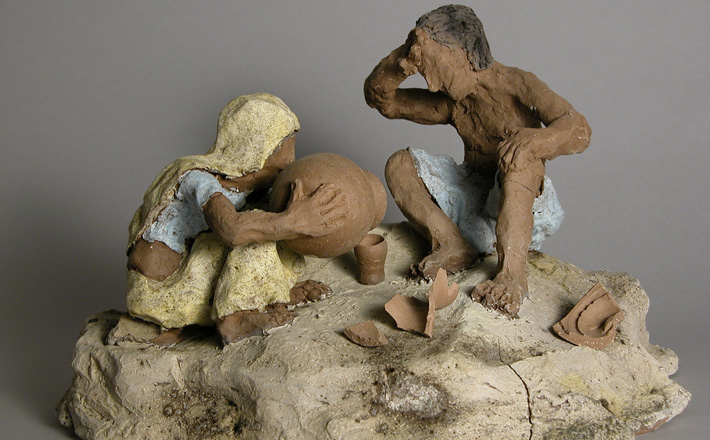Commentary on John 4:5-42
John 4 represents the founding narrative for the presence of a considerable number of Samaritans in the Johannine community.
It points to the diversity among the early Christian communities, and it legitimizes the discipleship of women.
It is presented in the form of a dialogue between Jesus and a woman of Samaria. Both are embedded in two different ethnic and religious groups, which provide the backdrop for their conversation. These two groups are the disciples and the Samaritan villagers.
Jesus
In this story, Jesus overcomes exclusiveness and builds community through inclusiveness. The former movement is negative; the latter is positive.
Overcoming exclusiveness:
As a Jewish male Jesus is in a position of advantage over the woman. But as a thirsty and tired sojourner he is obviously in disadvantage, for he is a foreigner and does not have a bucket to draw water.
After the woman’s initial surprise, Jesus invites the dialogue by becoming vulnerable (“Give me a drink”) and by allowing the woman to exercise some power over him (she is the one with the bucket!) The scene is paradoxical. Here is the giver of living water, thirsty himself. A thirsty Messiah and a resourceful woman will find out that they need each other, a wonderful metaphor for how God and humanity are intimately interconnected.
During the conversation, and after a play on words on the meaning of living water, Jesus overcomes his own Jewish cultic tradition by affirming that God is best worshipped in spirit. Thus, he does away with the temple institution both in Israel and in Samaria and points to a different eschatological reality, which he believes to be living in (verse 23, “and is now here”).
Building Community:
Jesus does this first by crossing gender boundaries and engaging the woman as a valid conversation partner to whom he makes the first self-revelation of the entire gospel: “I am he” (verse 26). By so doing he is de facto including women in the circle of disciples because the Samaritan woman goes back to the village and witnesses to the townspeople concerning Jesus. Consequently, they are able to make a Christological confession (verse 42).
Jesus also builds community by crossing racial boundaries and breaking the distinction between “chosen people” and “rejected people.” He extends the mission of the Jewish Messiah to the Samaritan people, who were hated by the Jews for their history of racial mixture and religious syncretism.
The Samaritan Woman
She is in clear disadvantage because of gender and race. But she has the advantage of being a local (Samaria is her home after all) and of having access to the water of the well, which Jesus lacks. Unlike Nicodemus in John 3, who seems to run out of questions as the dialogue progresses, this woman engages Jesus in a profound theological conversation.
She is the spokesperson for the Samaritans (notice the use of plural personal pronouns in verses 12, 20-22). She makes progressive affirmations of faith that prepare the way to her being sent as a witness (verse 39). When carefully read, this story provides the warrant for the presence of women among Jesus’ group of disciples. Two clues from the Johannine context will show this.
First, in 1:40, Andrew tells his brother Simon that he has found the Messiah and then brings him to Jesus. In 4:39, the woman’s testimony brings about the conversion of the Samaritans.
Second, in 1:46-49 Nathanael becomes a disciple after Jesus tells him his whereabouts under the fig tree. In 4:29 the woman becomes a witness to Jesus because of what Jesus told her. There is no doubt then that this woman is a witness to Christ, a disciple, just as much as the male disciples in 1:35-51.
A third disadvantage, besides those of gender and race, is the woman’s private life, her having had five husbands. But this is not necessarily proof of a licentious life. She could have been trapped in the custom of levirate marriage (see Tamar in Genesis 38) and the last male in the family line had refused to marry her.1 The text portrays her as an example of growing faith. The five husbands can also be a reference to people from five foreign nations who were brought as colonists by the Assyrians when they conquered the region in 721 B.C.E. (see 2 Kings 17:24). This created a situation of intermarriage that was aggravated by Herod the Great who continued with this pattern of colonization by settling thousands of foreigners in Samaria.2 If that is the case, then Jesus is commenting on the Samaritans’ mixed race and culture due to imperialism, not on her private life.
The Disciples
The disciples are the group to which Jesus relates ethnically and religiously. They are Jews (John 4:9). They appear at the beginning of the narrative, verse 8, and then after Jesus has finished his conversation with the woman, in verse 27, thus providing a rhetorical frame for Jesus conversation with her. Verses 7-30 can be structured in the following way:
A. A woman came to draw water (7)
B.The disciples had gone away into the city (8)
C. Dialogue between Jesus and the woman (9-26)
B. The disciples came back from the city (27)
A. The woman left the water jar and went back into the city (28)
In the narrative, the disciples stand for those people inside of the community who were not very enthusiastic about including non-Jews as fellow believers. The male disciples are summoned to participate in the mission but they must acknowledge that “others” have labored first. This is a veiled reference to the missionary work of the woman.
The Samaritan villagers
The Samaritan villagers acknowledge Jesus as the “Savior of the world,” not just the Jewish Messiah or the traditional Samaritan Ta’heb (“The one who returns”). This speaks of a new consciousness arising in the Johannine community that struggles to overcome cultural and national differences. Whatever it was that the woman told them, she did it in such a way that her conversation with Jesus was filtered through her own understanding of who Jesus was.
Even if, as Jesus said, salvation is for the Jews, it would not be limited to Israel alone but it would spill into the whole world. They initially believe because of the woman’s testimony (contrary to the Jewish disciples in 20:18-29) but then they themselves ascertain who Jesus is. Like the woman’s, their faith progresses.
What happened at the well that empowered the woman to become a witness of the gospel? Jesus treated her as a valid conversation partner, engaging her in serious theological conversation. The fact that he disagreed with some of the woman’s affirmations is the best proof that he was treating her with respect. Jacob Neusner, in his book A Rabbi talks with Jesus, explains that for a rabbi to argue and dialogue with others was a sign of respect: “It is my form of respect, the only compliment I crave from others, the only serious tribute I pay to the people I take seriously — and therefore I respect and even love.”3
The question of how Jesus was changed by the experience remains. If we can’t answer it, then we might have to conclude that this dialogue was staged, fabricated. I would rather think that because of this experience Jesus began to realize the universal scope of his mission. His ministry would not be bound by social, ethnic, or religious conventions. It was an exercise in inclusiveness similar to what he experienced with the Syrophoenician woman in Mark 7:24-30.
Thus, Jesus left us with a crucial lesson to be learned: community can only be built when we are not afraid of overcoming old prejudices and are willing to break the social conventions that dehumanize us. The living water that Jesus promised the woman, symbolized in the water that Moses made come out of the rock in Exodus 17, is God’s purifying water, the Holy Spirit (7:37-39), which can purify our hearts of old hatreds and hostilities and form us into a diverse people of God on earth.
Notes:
1 Gail R. O’Day, “The Gospel of John” in The New Interpreter’s Bible, Volume IX (Nashville: Abingdon, 1995), 567.
2 Craig R. Koester, Symbolism in the Fourth Gospel. Second Edition (Minneapolis: Fortress, 2003), 49.
3 Jacob Neusner, A Rabbi talks with Jesus. An Intermillennial, interfaith exchange (New York: Doubleday, 1993), 3.


March 19, 2017